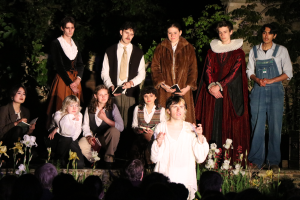
The Meaning of Arts Cuts
by Sam Dunnett | February 28, 2016
I am waiting to go onstage during my secondary school’s adaptation of The Canterbury Tales, wearing a shop-bought fancy dress costume that is meant to transform me into Geoffrey Chaucer. Other schools are putting on Hairspray and West Side Story. In whispers and gasps, news flits around the backstage area behind me. All that I can make out before I go on is that it is to do with The Brewhouse Theatre. By the time I arrive back in the shadows, the mutterings have shaped into a simple report, a single sentence that conveys exactly what has happened. The Brewhouse has closed. It has gone. Its doors have shut indefinitely. We all stand shocked, in our absurd medieval outfits.
Back in 2013, The Brewhouse was an arts centre and theatre, the only organisation of its kind in my hometown of Taunton. For me, it will always be the place where I spent bleary-eyed Saturday mornings in a black-room that smelled of paint and wallpaper glue; the catalyst for friendships that survive to this day; the setting for teenage crushes, arguments, raptures of imagination, and understanding of the world around me; the location of a truly disastrous adaptation of an Edward Bond play in which everybody forgot their lines. From my pre-teen years through to my late adolescence, the backrooms and corridors of the theatre became as familiar to me as those of my school, and the like-minded people I met there were as important to my sense of belonging in the town as any of my school friends were. I would be a different person without it.
Funding from Arts Council England saved The Brewhouse from two previous threats of closure, in 2005 and 2009. Then, in 2011, Somerset County Council responded to central government cuts with a one hundred per cent reduction in arts funding. The budget was replaced with roughly equal funding for ‘creative enterprises’, which, as community drama groups, public art classes, and secondary school instrument teachers soon learnt, translated as media and advertising. The Guardian called it ‘D-Day’ for the arts in Somerset, and it soon became clear that its effect was unambiguously to break organisations and projects across the county. All direct grants to arts groups ended immediately and The Brewhouse’s financial director warned of “death by a thousand cuts”.
The closure of my beloved theatre tapped into a gnawing suspicion of mine that many in positions of authority see the arts as expendable. To them, it didn’t matter that something was important to my memories, to my community, to my generation, to all perpetually exasperated inhabitants of provinces far from London where the arts are neglected; if it was deemed wasteful, it had to go. The loss of a theatre was my wake-up call that anything anyone values for its social rather than economic function is under threat from the same politically effective but logically inconsistent rhetoric: that of waste and thrift and tightening belts. Of course, there would have been far more damaging ways to learn how the narratives of austerity impact individual lives, but the lesson was the same. Even if theatres and arts centres are believed to be non-essential, not universal or egalitarian enough in the demographics they benefit, it is exactly the same reasoning that led to the slashing of funding for so much else from 2010 onwards, from Legal Aid to Housing.
Many political arguments for arts cuts ignore this link between everything endangered by the ideology of this government and the last one, and focus instead on comparing arts funding unfavourably with other public expenditure. At a 2015 general election hustings in Taunton, I watched the Labour parliamentary candidate justify his vote as a councillor for the one hundred per cent cut as a choice between support for vulnerable people and support for arts organisations. This dichotomy is dubious; others go further and argue that institutions such as the Brewhouse simply should not expect taxpayer’s money and that to survive they must learn to be commercially viable. When local Conservative MP Rebecca Pow was challenged by my sixth form’s politics society on the issue of arts funding, her response was that it was right that organisations were forced to examine their ‘economic sustainability’. According to her, all that happened in 2013 was that The Brewhouse resolutely failed the test presented by the removal of grants. It was unable to make youth clubs and public classes compatible with profitability, and was justly punished.
As it turned out, the Brewhouse did not close for good that February. It reopened the following April, its lease bought by the Taunton Theatre Association. Presumably Pow would be pleased that it now knows how to focus on making money. I soon learned what this meant in practice: for months after the theatre’s apparently permanent closure, this new state of affairs seemed to apply only to the state schools in the area. Private schools could afford the necessary rental fees to stage one-off performances of their end-of-term plays and musicals at the newly commercially-viable theatre. Our Canterbury Tales wouldn’t have stood a chance.
A year later, I raise this point anxiously, very conscious of the private school students sitting around the table. A few friends and I are in a cramped office space within the shell of The Brewhouse, surrounded by students from across Taunton. We have come together to demand a meeting with those responsible for the maintenance of the buildings and the potential return of the theatre. We want to ensure that youth services for students of all backgrounds are at the heart of any attempt to resurrect The Brewhouse. The meeting is undeniably disappointing. We know there will not be another one. I know, as I look into the face of the woman in charge of the preservation of the theatre, that I will never forget it. It is sad, and deeply pessimistic. She may not care. She may sincerely want to help. She may be dreading new ownership of the theatre, or she may have welcomed it when it finally came. Either way, she has been leading teams of people of all ages in clean-up operations for weeks: keeping the stage primed for unlikely future performances, lifting teetering stacks of chairs, dusting the corridors, cleaning lighting and sound equipment, washing the faded seats, preparing the dirty, ageing place for something new. Our concerns are a distraction.
I knew then that the following year, when I left for university, those battles would cease to be mine to fight. It would be a new generation that would benefit or lose out from how, when, and in what form the Brewhouse reopened. Our receding childhood memories, along with the opportunity for future young people to experience the theatre, were kept from despair, but only just. They teetered on the edge in the shadowy auditorium; hung on by their fingernails in the air of the hollow corridors I once loved.
Image by Zlatko Vickovic




